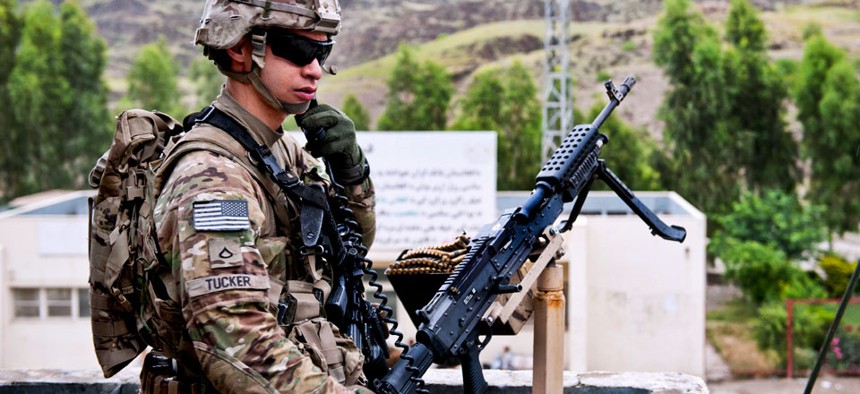Army Needs More Uniformed Personnel to Maintain Tactical Network Gear

U.S. Army Pfc. Robert Tucker talks on his radio while providing rooftop security for the customs checkpoint at Torkham Gate in Afghanistan's Nangarhar province, April 24, 2013. U.S. Army
The service is becoming too dependent on civilian techs.
The Army needs to raise the number of uniformed personnel managing and maintaining its increasingly complex battlefield communications networks, the Pentagon’s test organization urged in its annual report to Congress.
J. Michael Gilmore, director of operational test and evaluation for the Defense Department, evaluated two Army exercises conducted last year at Ft. Bliss, Texas, and White Sands Missile Range, N.M., by the 2nd Brigade, 1st Armored Division. Gilmore determined that unit lacked the personnel to support a wide range of sophisticated radios and satellite communications gear.
The Army has added a large number of new network components without a corresponding increase in signal soldiers to manage and maintain these components, the report said, a situation that “has considerably increased the demands upon the signal soldiers who are available.”
There are currently insufficient signal soldiers assigned to the 2nd brigade to effectively operate and maintain the increased number of network components, the report said, noting implications for fielding of new tactical communications systems across the Army.
The Army should “evaluate the force structure implications of adding a large amount of new communications equipment into tactical units without a corresponding increase in support personnel,” the report said.
New Army radios which use software to define frequency, bandwidth and security impose a heavy load on uniformed network support personnel, Gilmore reported. It took 25 minutes to load software on a single manpack radio during a network test in 2012, and “it took two soldiers 2 to 3 days to set up and load all 46 Manpack radios and 96 Rifleman Radios in the test company.”
Due the lack of uniformed signal personnel, Army units remain “overly dependent” on civilian field service representatives “to establish and maintain the integrated network. This dependency corresponds directly to the excessive complexity of use of network components,” the report said.
The Army has focused on fielding its new network equipment on Humvees and Mine-Resistant Ambush Protected vehicles over the past three years and now faces “the challenge of integrating network components into tracked combat vehicles [which] remains unresolved,” the report said.
“Due to vehicle space and power constraints, the Army has yet to successfully integrate desired network capabilities into Abrams tanks and Bradley infantry fighting vehicles. It is not clear how the desired tactical network will be incorporated into heavy brigades,” the report warned.






